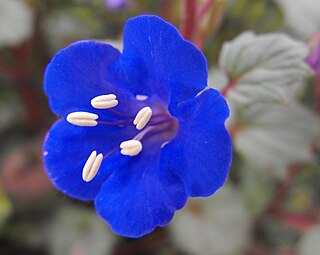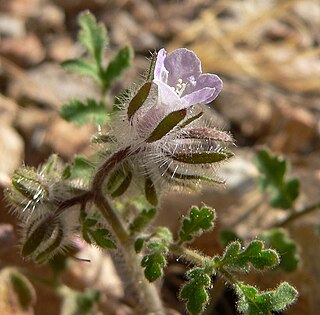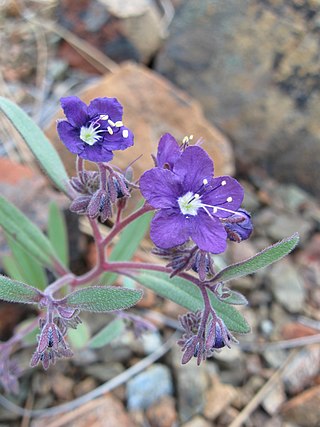
Phacelia campanularia is a species of flowering plant in the borage family, Boraginaceae, known by the common names desertbells, desert bluebells, California-bluebell, desert scorpionweed, and desert Canterbury bells. Its true native range is within the borders of California, in the Mojave and Sonoran Deserts, but it is commonly cultivated as an ornamental plant and it can be found growing elsewhere as an introduced species.
Phacelia austromontana is a species of phacelia known by the common name Southern Sierra phacelia. It is native to the southwestern United States, where it can be found in the Transverse Ranges and Sierra Nevada of California east to Utah. It grows in open mountainous habitat.

Phacelia cookei is a rare species of phacelia known by the common name Cooke's phacelia. It is endemic to Siskiyou County, California, where it is known from just a few occurrences in the forest and scrub around Mount Shasta. The substrate in the area is sandy, ashy volcanic soil.

Phacelia cryptantha is a species of flowering plant in the borage family, Boraginaceae, known by the common name hiddenflower phacelia. It is native to the southwestern United States and Baja California in Mexico, where it grows in several habitat types in desert, rocky mountain slopes, canyons, plateau, and other areas.

Phacelia exilis is a species of phacelia known by the common names Transverse Range phacelia and lavender windows. It is endemic to California, where it is known from the southern Sierra Nevada and the Transverse Ranges. It grows in mountain and foothill habitat such as slopes and meadows.

Phacelia greenei is a species of phacelia known by the common name Scott Valley phacelia. It is endemic to the southern Klamath Mountains of far northern California, where it is known only from Scott Valley, a valley known for its alfalfa growing, and vicinity.
Phacelia inundata is a species of phacelia known by the common names playa yellow phacelia and playa phacelia. It is native to the Modoc Plateau and surrounding areas in Oregon, western Nevada, and northeastern California, where it grows in the alkaline soils of playas and dry lakebeds.
Phacelia marcescens is a species of phacelia known by the common name persistentflower phacelia. It is endemic to the Sierra Nevada and its foothills in California, where it grows in meadows, forests, and other mountain habitat.

Phacelia monoensis is an uncommon species of phacelia known by the common name Mono County phacelia.

Phacelia mutabilis is a species of flowering plant in the borage family known by the common name changeable phacelia. It is native to the western United States and Baja California, where it can be found in mountains and foothills, in forested and open habitat types, and deserts.

Phacelia nashiana is a species of phacelia known by the common name Charlotte's phacelia. It is endemic to California, where it is known only from the ecotone where the lower Sierra Nevada and Tehachapi Mountains transition into the Mojave Desert. It grows in scrub and woodland and on granite mountain slopes.

Phacelia neglecta is a species of flowering plant in the borage family, Boraginaceae. Its common names include alkali phacelia and neglected scorpionweed. It is native to the deserts of the southwestern United States in Nevada, Arizona, and southeastern California, where it grows in varied desert habitat, including areas with alkali soils. It is likely that its distribution extends into Baja California.

Phacelia pachyphylla is a species of phacelia known by the common name blacktack phacelia. It is native to the deserts of California and Baja California, where it grows in sandy alkali flats and scrub.

Phacelia parryi is a species of phacelia known by the common name Parry's phacelia.

Phacelia pringlei is a species of flowering plant in the borage family known by the common name Pringle's phacelia. It is endemic to far northern California, where it is known only from the southern Klamath Mountains. It grows in coniferous forest and open mountain slopes.
Phacelia racemosa is a species of phacelia known by the common name racemose phacelia.
Phacelia rattanii is a species of phacelia known by the common name Rattan's phacelia.

Phacelia tanacetifolia is a species of flowering plant in the borage family Boraginaceae, known by the common names lacy phacelia, blue tansy, purple tansy or fiddleneck (UK).
Phacelia vallicola is a species of phacelia known by the common name mariposa phacelia. It is endemic to California, where it is known only from the Sierra Nevada and adjacent southernmost slopes of the Cascade Range. It grows in coniferous forest, chaparral, and other mountain and foothill habitat.

Phacelia vallis-mortae is a species of flowering plant in the borage family, Boraginaceae, known by the common name Death Valley phacelia. It is native to the southwestern United States, where it grows in deserts such as Death Valley, and mountain, plateau, and valley scrub habitat.













